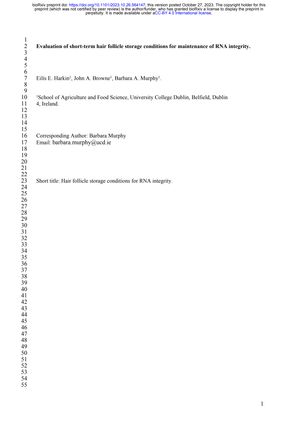TLDR Hair follicles can be kept in RNAlater® at cool or room temperature for a week without harming RNA quality.
This study evaluated the RNA integrity in horse hair follicle samples preserved in RNAlater® under different short-term storage conditions. Samples from three horses were stored at 4°C for 24 hours or 7 days, or at room temperature (19°C) for 7 days, before being decanted and stored at -20°C. RNA concentration and quality were measured, with results showing no significant difference between the groups (Group A: 516 +/-125 ng/ml and RIN 9.5 +/-0.19; Group B: 273+/-93 ng/ml and RIN 9.8+/-0.09; Group C: 476+/-176 ng/ml and RIN 9.2+/-0.35). Additionally, qPCR validation assays confirmed high-quality template cDNA across all groups. The study concludes that hair follicles can be stored in RNAlater® at cool or room temperature for one week without compromising RNA integrity, allowing for extended transport times from remote locations without freezing.
 5 citations
,
January 2023 in “International Journal of Molecular Sciences”
5 citations
,
January 2023 in “International Journal of Molecular Sciences” Hair follicles could be used to noninvasively monitor our body's internal clock and help identify risks for related diseases.
1 citations
,
July 2022 in “British Journal of Dermatology” Targeting specific genes in certain pathways may help treat male pattern baldness.
 12 citations
,
December 2021 in “Aging”
12 citations
,
December 2021 in “Aging” A new painless method to collect hair follicles helps study DNA damage and aging.
10 citations
,
December 2017 in “Physiological Reports” Hair follicle analysis can track body changes from high-intensity interval training.
 10 citations
,
August 2014 in “PLoS ONE”
10 citations
,
August 2014 in “PLoS ONE” Hair follicles can help diagnose traumatic brain injury quickly and non-invasively.
92 citations
,
September 2013 in “Journal of Investigative Dermatology” BMAL1 and Period1 genes can influence human hair growth.
 15 citations
,
October 2012 in “Journal of circadian rhythms”
15 citations
,
October 2012 in “Journal of circadian rhythms” RNA from horse hair follicles can track circadian rhythms non-invasively.
 166 citations
,
August 2010 in “Proceedings of the National Academy of Sciences of the United States of America”
166 citations
,
August 2010 in “Proceedings of the National Academy of Sciences of the United States of America” Scientists found a new, less invasive way to study body clocks using hair cells, which shows shift workers' body clocks don't match their lifestyles.
 24 citations
,
May 2019 in “PLOS ONE”
24 citations
,
May 2019 in “PLOS ONE” The African spiny mouse can fully regenerate its muscle without scarring, unlike the common house mouse.
73 citations
,
December 2015 in “Nature Genetics” Mutations in TBX3 cause horses to have more even hair color instead of Dun camouflage.
 6 citations
,
April 2022 in “Frontiers in cell and developmental biology”
6 citations
,
April 2022 in “Frontiers in cell and developmental biology” The research identified key proteins and genes that may influence wool bending in goats.
 12 citations
,
December 2021 in “Aging”
12 citations
,
December 2021 in “Aging” A new painless method to collect hair follicles helps study DNA damage and aging.
FGF9 helps hair follicles grow in small-tailed Han sheep by affecting cell growth and certain signaling pathways.








